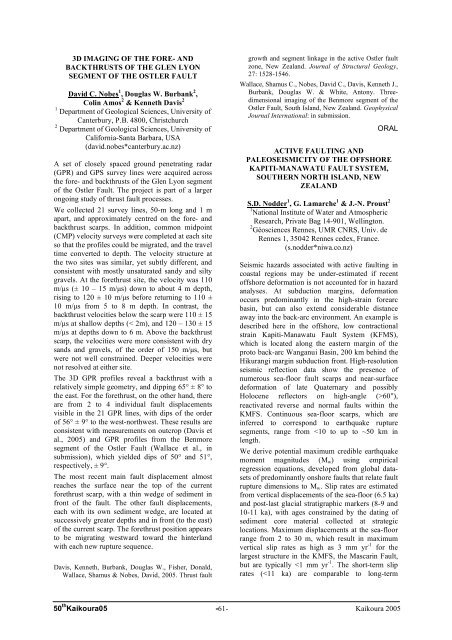50thKaikoura05 -1- Kaikoura 2005 CHARACTERISATION OF NEW ...
50thKaikoura05 -1- Kaikoura 2005 CHARACTERISATION OF NEW ...
50thKaikoura05 -1- Kaikoura 2005 CHARACTERISATION OF NEW ...
You also want an ePaper? Increase the reach of your titles
YUMPU automatically turns print PDFs into web optimized ePapers that Google loves.
3D IMAGING <strong>OF</strong> THE FORE- AND<br />
BACKTHRUSTS <strong>OF</strong> THE GLEN LYON<br />
SEGMENT <strong>OF</strong> THE OSTLER FAULT<br />
David C. Nobes 1 , Douglas W. Burbank 2 ,<br />
Colin Amos 2 & Kenneth Davis 2<br />
1 Department of Geological Sciences, University of<br />
Canterbury, P.B. 4800, Christchurch<br />
2 Department of Geological Sciences, University of<br />
California-Santa Barbara, USA<br />
(david.nobes*canterbury.ac.nz)<br />
A set of closely spaced ground penetrating radar<br />
(GPR) and GPS survey lines were acquired across<br />
the fore- and backthrusts of the Glen Lyon segment<br />
of the Ostler Fault. The project is part of a larger<br />
ongoing study of thrust fault processes.<br />
We collected 21 survey lines, 50-m long and 1 m<br />
apart, and approximately centred on the fore- and<br />
backthrust scarps. In addition, common midpoint<br />
(CMP) velocity surveys were completed at each site<br />
so that the profiles could be migrated, and the travel<br />
time converted to depth. The velocity structure at<br />
the two sites was similar, yet subtly different, and<br />
consistent with mostly unsaturated sandy and silty<br />
gravels. At the forethrust site, the velocity was 110<br />
m/µs (± 10 – 15 m/µs) down to about 4 m depth,<br />
rising to 120 ± 10 m/µs before returning to 110 ±<br />
10 m/µs from 5 to 8 m depth. In contrast, the<br />
backthrust velocities below the scarp were 110 ± 15<br />
m/µs at shallow depths (< 2m), and 120 – 130 ± 15<br />
m/µs at depths down to 6 m. Above the backthrust<br />
scarp, the velocities were more consistent with dry<br />
sands and gravels, of the order of 150 m/µs, but<br />
were not well constrained. Deeper velocities were<br />
not resolved at either site.<br />
The 3D GPR profiles reveal a backthrust with a<br />
relatively simple geometry, and dipping 65° ± 8° to<br />
the east. For the forethrust, on the other hand, there<br />
are from 2 to 4 individual fault displacements<br />
visible in the 21 GPR lines, with dips of the order<br />
of 56° ± 9° to the west-northwest. These results are<br />
consistent with measurements on outcrop (Davis et<br />
al., <strong>2005</strong>) and GPR profiles from the Benmore<br />
segment of the Ostler Fault (Wallace et al., in<br />
submission), which yielded dips of 50° and 51°,<br />
respectively, ± 9°.<br />
The most recent main fault displacement almost<br />
reaches the surface near the top of the current<br />
forethrust scarp, with a thin wedge of sediment in<br />
front of the fault. The other fault displacements,<br />
each with its own sediment wedge, are located at<br />
successively greater depths and in front (to the east)<br />
of the current scarp. The forethrust position appears<br />
to be migrating westward toward the hinterland<br />
with each new rupture sequence.<br />
Davis, Kenneth, Burbank, Douglas W., Fisher, Donald,<br />
Wallace, Shamus & Nobes, David, <strong>2005</strong>. Thrust fault<br />
growth and segment linkage in the active Ostler fault<br />
zone, New Zealand. Journal of Structural Geology,<br />
27: 1528-1546.<br />
Wallace, Shamus C., Nobes, David C., Davis, Kenneth J.,<br />
Burbank, Douglas W. & White, Antony. Threedimensional<br />
imaging of the Benmore segment of the<br />
Ostler Fault, South Island, New Zealand. Geophysical<br />
Journal International: in submission.<br />
ORAL<br />
ACTIVE FAULTING AND<br />
PALEOSEISMICITY <strong>OF</strong> THE <strong>OF</strong>FSHORE<br />
KAPITI-MANAWATU FAULT SYSTEM,<br />
SOUTHERN NORTH ISLAND, <strong>NEW</strong><br />
ZEALAND<br />
S.D. Nodder 1 ,G.Lamarche 1 &J.-N.Proust 2<br />
1 National Institute of Water and Atmospheric<br />
Research, Private Bag 14-901, Wellington.<br />
2 Géosciences Rennes, UMR CNRS, Univ. de<br />
Rennes 1, 35042 Rennes cedex, France.<br />
(s.nodder*niwa.co.nz)<br />
Seismic hazards associated with active faulting in<br />
coastal regions may be under-estimated if recent<br />
offshore deformation is not accounted for in hazard<br />
analyses. At subduction margins, deformation<br />
occurs predominantly in the high-strain forearc<br />
basin, but can also extend considerable distance<br />
away into the back-arc environment. An example is<br />
described here in the offshore, low contractional<br />
strain Kapiti-Manawatu Fault System (KFMS),<br />
which is located along the eastern margin of the<br />
proto back-arc Wanganui Basin, 200 km behind the<br />
Hikurangi margin subduction front. High-resolution<br />
seismic reflection data show the presence of<br />
numerous sea-floor fault scarps and near-surface<br />
deformation of late Quaternary and possibly<br />
Holocene reflectors on high-angle (>60°),<br />
reactivated reverse and normal faults within the<br />
KMFS. Continuous sea-floor scarps, which are<br />
inferred to correspond to earthquake rupture<br />
segments, range from















